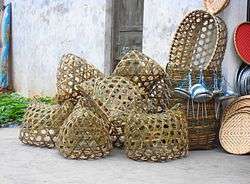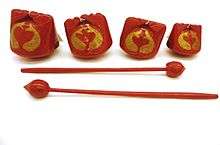Chinese folk art

Chinese folk art are artistic forms inherited from a regional or ethnic scene in China. Usually there are some variation between provinces. Individual folk arts have a long history, and many traditions are still practiced today. The general definition of folk art incorporates Chinese art forms that are not classified as Chinese fine art.
Basket weaving
Baskets are mainly woven with bamboo or plant stems.
Chinese kites
China is the birthplace of the kite and Weifang is one of the chief places where Chinese kites originated. Kite-flying became prevalent in Weifang in the Song Dynasty (960-1279). By the Ming Dynasty (1368–1644) kite-flying had become even more popular, and kite fairs on a rather large scale had appeared. Kites were sold not only across Shandong, but also to Jiangsu, Fujian, Anhui and other places. The noted English scholar Joseph Needham listed kites in his book History of Science and Technology in China as one of the important contributions in science and technology that the Chinese introduced to Europe.
-

Photograph of the entrance hall of the Kite Museum in Weifang, Shandong, China.
Food art
Sugar people
Sugar people (糖人) is a traditional Chinese form of folk art using hot, liquid sugar to create three-dimensional figures.
-

Sugar figures
Flour figures
Mian Ren (Flour Figure) are made of coloured flours. Craftsmen used to travel with their tools to villages and towns to make and sell flour figures for a very basic income. Sometimes flour figures are used in dishes together with vegetable carvings.
Paintings
Folk art paintings
-
.jpg)
Ren Shuai Ying, Chang'e Flying to the Moon
-

Hua Sanchuan, The seventh fairy maiden, 1980
Paper art
The first two forms of paper art began in the Han Dynasty with Chinese Paper Cutting and Chinese Paper Folding, including the Hand Fan and Pinwheel (toy). These arts have expanded globally.
Performances
Puppetry
One of the oldest forms of folk art is puppetry. Puppeteers use various kinds of puppets, including marionettes, glove puppets, rod puppets, cloth puppets and wire puppets in performances incorporating folk songs and dances over some dialogues. The subject matter is derived mainly from children's stories and fables.
Shadow play
Chinese Shadow theatre is a form of puppetry that is performed by moving figures made of animal skins or cardboard held behind a screen lit by lamplight. The subject matter and singing style in shadow plays are closely related to Chinese opera, except without using live actors or actresses.
-
Chinese Shadow Play Figures, Two warriors; Qianlong era set; approx. 1780, Deutsches Ledermuseum, Offenbach, Germany
Textile arts
Chinese knot

Chinese knotting (中國結) is a decorative handicraft art that began as a form of Chinese folk art in the Tang and Song Dynasty (960-1279 AD) in China. It was later popularized in the Ming. The art is also referred to as Chinese traditional decorative knots.[1] One of the more traditional art forms, it creates decorative knot patterns. During the Culture revolution it was not practiced, but nowadays it is very popular again.
In other cultures, it is known simply as "Decorative knot".
Tiger-head shoes
Tiger-head shoes (虎头鞋) are an example of traditional Chinese folk handicraft used as footwear for children. Their name comes from the toe cap, which looks like the head of a tiger.
Musical instruments
Bolang gu, a traditional Chinese pellet drum and toy.
Muyu, a rounded woodblock carved in the shape of a fish, it is played by striking the top with a wooden stick; often used in Buddhist chanting.
See also
- Chinese art
- Chinese fine art
- Chinese games
- Culture of China
References
- ↑ Chang, 2006).
Bibliography
- Chang, Zonglin. Li, Xukui. (2006). Aspect of Chinese culture. 中国文化导读. 清华大学出版社 publishing



